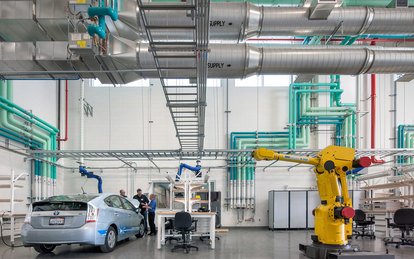Fourth Industrial Revolution: Are You Ready?

Gone are the days during which we revel in the power and speed of the printing press. In this age, we can 3-D print our own toothbrushes and walk the Great Wall of China from the comfort of our living rooms. The 4th Industrial Revolution is upon us and as stewards of innovative design we must ask ourselves and our communities… are we ready?
SmithGroup posed this question at the most recent Perspectives event hosted by our Phoenix office. Participants from the worlds of architecture, development, research, and construction observed an expert panel as they tackled questions like, “How will rapidly developing technology influence a human-centric workforce?”, “What will our typical days look like thirty years from now?”, “What coming technologies will help to drive change?”, and “How should we be designing spaces to support both humans and artificial intelligence?”
When asked how an ever-advancing world of technology can be capitalized upon in building design, the common theme amongst panelists was the deep need for a human factor. Kristin Piotrowski, Senior Global Logistics Manager at Axon shared that she and her colleagues are questioning the usefulness and security of the Cloud. Axon’s products and protocols are extremely sensitive and require monitoring from every angle, and the concern of cybersecurity is being addressed as the organization’s new Scottsdale, Arizona facility is coming to fruition.
I found Kristin’s response to this concern to be inspiring: a desire for a building that addresses and weaves into the company’s needs. It is my belief that in order to keep pace with technology we must envision our buildings’ lifespans in categories: technology, infrastructure, and systems. Our designs should cater to our clients’ needs and eradicate their fears by creating safety nets for technology eight years out; safety nets for the building 50 years out; and safety nets for internal systems 50 or more years out.

My case for longevity resonated with Rich Bowen, Associate Vice President in the Office of the President at Northern Arizona University, who sees examples of the success of designing buildings for technologic longevity within the TGEN North project. The TGEN North space does not require additional staffing or specialized equipment because the infrastructure was created in anticipation of necessary machinery gradually becoming smaller. Rich shared that this win occurred with a private research partner and proved to be a major triumph for the university.
Doug Woodruff, West Region Executive Senior Vice President at Wexford Science & Technology chimed in with his perspective on private research partnerships, sharing that these clients value flexible space. In fact, some tenants are leasing space for a week at a time. Woodruff celebrates the fact that flexible, technology-welcoming environments allow for a new wave of diverse tenants.
The undeniable truth is that a revolution is upon us. Gaining exposure to the triumphs and pitfalls of this shift will equip us with the necessary tools, realities, and frames of mind to continue moving forward successfully.
